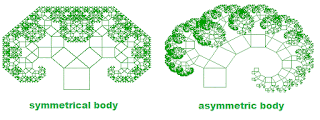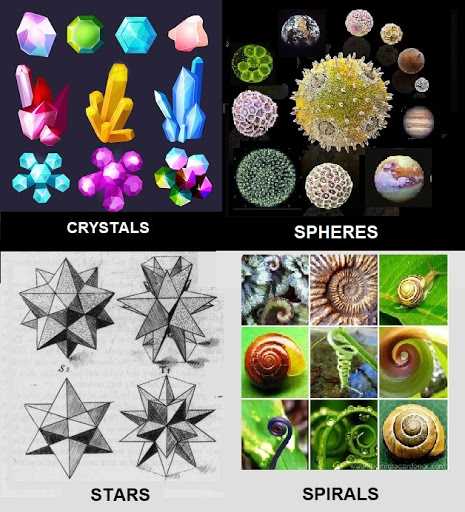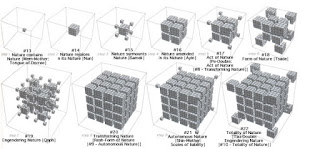What is a point?
It is something that has no dimension, we theoretically relate it to a place of reference, the place where something begins, the location of something. Physically we could say that it is the mark left by the tip of the pencil on paper.
What is a line?
A sequence of points have a one-dimensional shape called a line.
A sequence of points have a one-dimensional shape called a line.
What is a plane?
What is a volume?
The placement of planes, one on top of another forms a three-dimensional figure called volume.
Is there a new Dimension?
When it comes to giving the description of a four-dimensional object, we encounter problems, however through abstract reasoning we can develop a method that gives us a vision of what a structure of this type is.
To begin with, in the formation of the line, the plane and the volume there are several elements in common, for example, in all three there is always a displacement, the point is displaced and the line is formed, the line is displaced and the plane is formed, the plane is displaced and the volume is formed. There are also two other common elements such as time and space (a displacement implies a given time, and this in turn gives us a space), for example, the successive placement of a point next to another point for a time "t ", forms a line of size "X", the successive placement of a line next to another line for a time "t", gives us a plane of size "X*Y" (length by width), and finally, the successive placement of a plane on another plane for a time "t" forms a volume of size "X * Y * Z" (length by width by height). Making used abstract reasoning, we could infer that a volume placed on another volume for a time "t" forms a figure of size "X * Y * Z * N", that is, X, Y and Z multiplied N times. Here we have formed a four-dimensional structure. To describe that number of times, we will use W instead of the letter N, following the sequence of the other three dimensions, X, Y and Z. We are going to give this figure of size X, Y, Z and W the name of “BODY” and its development, we will call it “DEPTH”. The words BODY and DEPTH were the most appropriate to name this new dimension given its "organic" development, and this name is not free, since as we will see later, the beings of the Universe are organic formations, an accumulation of volumes.
Then, we can conclude that a " something " four-dimensional is formed by placing a volume next to another volume during a time " t", and this operation the called DEPTH, and this “something” will be called BODY, changing slightly that definition of BODY that according to the dictionary is each of the parts of a whole, we will say that BODY is the whole formed by each of the parts and this is the name that we will apply hereafter to describe that “something” in Four Dimensions. We already have the name for our four-dimensional structure, but we still do not know what that other direction is in which a four-dimensional BODY develops, nor do we know its structure.
To know his figure we are going to add volumes indefinitely until we obtain a form and a direction for the Fourth Dimension. This operation of adding volumes can be done in many possible ways, and in many different environments, the type or types of volumes that we accumulate and the way this accumulation occurs, is finally that which gives the form of the BODY or four-dimensional structure.
For example, if we were in outer space (where the force is equal in all directions) and volumes will accumulate indefinitely for a given time, we would have a spherical shape figure, no matter what kind of volume we accumulate,the same forces in all directions makes an accumulation of volumes have the characteristics of a sphere, and this is very clear when observing the planets and living beings. In a middle place between the ocean floor and its surface, there are equal forces in all directions, any structure composed of an accumulation of volumes that is form there, will acquire spherical shape. We already know a type of structure in four dimensions, the sphere, and from it we get the direction we needed, it is the direction to where the body is formed, which in this particular case is the radius of the sphere.
We could conclude that the depth W corresponding to a fourth-dimensional body is the radius of the sphere, and this is the direction of the fourth dimension , Therefore an accumulation of volumes in a place where there are equal forces in all directions, forms a sphere tetradimensional thats called body. If we integrate a cube between 0 and a spherical surface making the cube increasingly small and the spherical surface, large enough, surely what you get is a spherical body composed of infinite number of cubes, which meets the definition of fourth dimension: - An accumulation of volumes in a direction W, is a sphere fourt-dimensional-. Just as the cube is the most usual representation of a three-dimensional object (tetrahedron, parallelogram, icosahedron, and others are also three-dimensional objects), the sphere is the most usual representation of a four-dimensional object.
Now, well, an accumulation of volumes, does not necessarily produce a spherical BODY, it all depends on the three-dimensional volume we accumulate and the environment where we do it. There are other BODIES such as crystals that are accumulation of symmetrical volumes in a single direction, have no spherical surfaces, these forms are given for example on the surface of the earth, or when the accumulation is done in an orderly way, ie each volume fits perfectly with all others and are very common, for example, int all known crystals.
All these bodies in ideal conditions of growth are highly symmetrical, and acquire beautiful forms called crystals. They all correspond to the accumulation of the same pattern or volume, fitting precisely to each other, acquiring characteristics as particular as diamond, smooth, transparent and sometimes very hard surfaces.
When an accumulation of asymmetric volumes is made, those whose right side is different from the left (if at a three-dimensional volume we draw an imaginary line, and its right side is different to its left side we say it is asymmetrical) the BODY that Is formed acquires the characteristics of a spiral. Each volume brings a small twist to the whole forming a helical BODY, the “accommodation” that makes an asymmetrical volume fit into another produces that “twist” that finally leads us to a helical BODY.
For example, to an M-shaped volume we will draw an imaginary line in the mid and we would obtain that the right side is equal to the left, this is a symmetrical volume, if at an L-shaped volume we draw an imaginary line, We will never achieve that its right side is equal to the left, this is an asymmetrical volume, when we accumulate volumes in the form of “L” we have to accommodate each volume in the other, this accommodation generates a turn, and every new “L “ increase a turn more, finally, that accumulation of turns produces a body of four dimensions with form of spiral. The number of turns creates unique and very beautiful shapes.
This type of bodies gave rise to life on earth, we could safely say that asymmetric molecules were the origin of living beings. Shells of snails, human hair, horns of some animals, as well as the DNA molecule are an accumulation of asymmetrical volumes (each volume is a small molecule asymmetric either of silicon in the case of the shell or Protein in the hair), and therefore their characteristic spiral shape that make them be beautifully shaped bodies.
This type of bodies gave rise to life on earth, we could safely say that asymmetric molecules were the origin of living beings. Shells of snails, human hair, horns of some animals, as well as the DNA molecule are an accumulation of asymmetrical volumes (each volume is a small molecule asymmetric either of silicon in the case of the shell or Protein in the hair), and therefore their characteristic spiral shape that make them be beautifully shaped bodies.
Another way to obtain a BODY is to develop a volume inside another, it is the growth of a solid inside another, forming BODIES in the form of a star, it happens when, for example, we insert a cube inside another, in such a way that the corners Of one go through the faces of the other. These forms are very common in nature, and we find them when some chemical compounds are formed by the growth of a volume of one element within the volume of another.
We can conclude that in a tetra dimensional or fourth-dimensional space, we have four types of forms: Spherical BODIES, formed by an infinite accumulation of volumes in a space with equal forces in all directions; The CRYSTALS, formed by accumulation of volumes in a single direction and under the severe geometric laws of regular repetition of networks in space; The helical bodies, formed by asymmetrical volumes where each one of them contributes a small twist giving the characteristic form of propeller and the BODIES of Kepler-Poinsot that is the ordered growth of a volume inside another volume, resulting in BODIES in form of star.
Infinite accumulation of volumes
Volume-seed in three dimensions and its presentation in 4 dimensions
The bodies in 4 dimensions are really extraordinary.










